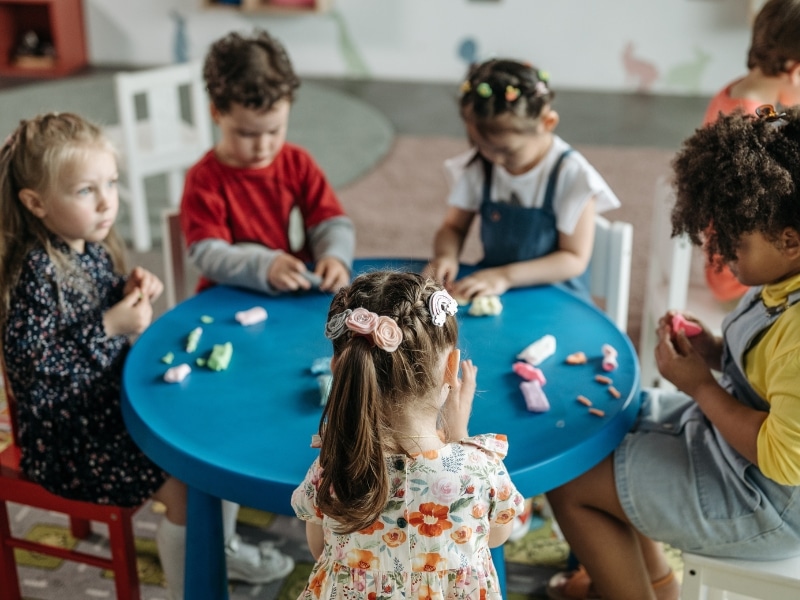How Do Preschool Programs Cater to Different Learning Styles?

Preschool programs play an essential role in shaping a child’s early development. One key aspect is how these programs cater to children’s different learning styles. Understanding that each child learns uniquely is crucial to providing effective education. Preschool educators are increasingly aware of these differences and tailor their approaches to meet the needs of each child. This article will explore how preschool programs can effectively cater to different learning styles, ensuring every child thrives in their learning environment.
What are learning styles in early childhood education?
Learning styles refer to the different ways individuals process and retain information. Understanding these styles helps educators create personalised experiences for each child in early childhood education.
Here are the main types of learning styles that are commonly recognised:
- Visual learners: Children who learn best through seeing. They understand and retain information better when presented visually, such as through charts, images, or written instructions.
- Auditory learners: These children learn best by hearing. They thrive in environments where information is delivered through songs, stories, and verbal instructions.
- Kinesthetic learners: Kinesthetic learners need to engage in physical movement to learn. They learn best when acting out concepts or manipulating objects to understand lessons.
- Tactile learners: Like kinesthetic learners, tactile learners benefit from hands-on experiences. They excel when they can touch and manipulate materials to explore new concepts.
Understanding these different learning styles in preschool helps educators develop more effective teaching methods and provide a better overall experience for young children.
Why is it important to cater to different learning styles in preschool?
Catering to different learning styles in preschool is essential for a few key reasons:
- Maximises learning potential: Various teaching methods increase children’s likelihood of understanding and retention of information.
- Encourages engagement: When learning is tailored to a child’s style, they are more engaged and excited to learn.

- Supports individual development: Each child develops at their own pace. Adjusting the teaching approach to their learning style ensures they receive the support they need.
- Promotes inclusion: Recognising different learning styles promotes an inclusive environment where every child can succeed.
- Fosters self-confidence: Children who learn in a way that suits them are more likely to feel confident in their abilities.
Catering to different learning styles in preschool helps children maximise their learning potential and fosters engagement. Furthermore, it ensures each child feels supported in their educational journey.
How can play-based learning support different learning styles?
Play-based learning supports different learning styles by using activities that match how children learn best. The table below highlights the connection between play activities and learning styles.
| Style | Play activity type | Learning support |
| Visual | Puzzles, Art, Storytelling | Engage with visuals, colours, and images |
| Auditory | Songs, Storytelling, Discussions | Learn through sound and verbal communication |
| Kinesthetic | Physical Games, Block Building, Role-playing | Learn through movement and hands-on activities |
| Tactile | Sensory Play (water, sand, clay) | Explore through touch and physical sensations |
This table shows how play-based activities can cater to different learning styles, fostering a more inclusive approach to education.
Is there a one-size-fits-all approach to preschool learning?
There is no one-size-fits-all approach to preschool learning, as children develop at different rates and interact uniquely with the world around them. Preschool programs need to be adaptable and cater to the needs of each child. Key considerations include:
- Individual learning pace: Some children may grasp concepts faster than others, requiring a more personalised approach.
- Variety of learning methods: Offering a mix of activities that boost cognitive skills and appeal to different learning styles ensures that no child is left behind.
- Flexible environment: A dynamic environment for structured activities and free play encourages growth across various domains.
- Responsive teaching strategies: Teachers must be responsive to each child’s progress and adapt lessons accordingly.
A one-size-fits-all approach is not effective in preschool learning. Therefore, adaptable and flexible teaching methods that cater to individual learning needs are essential, as they ensure that each child can thrive.
What strategies help auditory learners in preschool?
Auditory learners in preschool benefit from strategies that engage their sense of hearing. Here are some effective strategies to help auditory learners succeed:
- Songs and rhymes: Using music and rhythmic activities helps reinforce language concepts and vocabulary.
- Storytelling: Reading stories aloud engages auditory learners and helps them comprehend and retain information.

- Verbal instructions: Clear, concise instructions allow auditory learners to process information more effectively.
- Group discussions: Encouraging conversation and group discussions helps auditory learners verbalise and reinforce their understanding.
- Listening exercises: Simple listening activities, such as identifying sounds or following verbal directions, engage auditory learners.
Educators can better support auditory learners by incorporating songs, storytelling, and verbal instructions into preschool programs. As a result, this will help them connect with the material and, in turn, enhance their learning experience.
Why is it essential for parents to understand learning styles?
Understanding your child’s learning style can be incredibly beneficial as a parent. It allows you to support your child’s learning at home in a way that aligns with their strengths. Early childhood education is important for a child as it lays the foundation for their long-term academic and social development. Here are a few reasons why this understanding is essential:
| Benefit | Impact | Outcome |
| Better support at home | Reinforces learning strategies | Aligns with child’s learning style |
| Fostering positive attitude | Develops love for learning | Encourages a lasting interest in education |
| Improved communication with teachers | Facilitates meaningful discussions | Ensures child’s needs are met |
| Helping with homework | Makes tasks more effective | Increases enjoyment and engagement |
Knowing your child’s learning style, therefore, enables parents to provide targeted support, enhance their child’s educational journey, and foster a positive, lifelong love of learning.
How do preschool programs integrate multiple learning styles?
Preschool programs integrate multiple learning styles through various teaching methods and activities that engage children on different levels. Here are some ways preschool programs cater to various learning styles:
- Hands-on activities: Incorporating tactile, hands-on experiences that allow children to touch, feel, and explore while engaging their other senses.
- Use of technology: Interactive learning apps or videos can cater to visual and auditory learners, providing a more dynamic learning experience.
- Diverse learning materials: Offering a mix of books, toys, art supplies, and musical instruments ensures that all learning styles are addressed during activities.
- Flexibility in teaching methods: Preschools can incorporate various teaching methods, from direct instruction to group activities, to ensure that all children can learn in ways that suit them best.
A tailored preschool program can support children’s diverse learning styles by integrating visual, auditory, kinesthetic, and tactile activities into daily routines.
Conclusion
Catering to different learning styles in preschool is essential for ensuring every child’s success. In addition, play-based learning, flexible teaching strategies, and various engaging activities can help children thrive in a way that best suits their needs. Furthermore, by understanding and supporting different learning styles, educators and parents can provide children with the tools they need to reach their full potential.
Looking for a preschool that understands your child’s unique learning style? See how Innocent Minds can support their growth.
